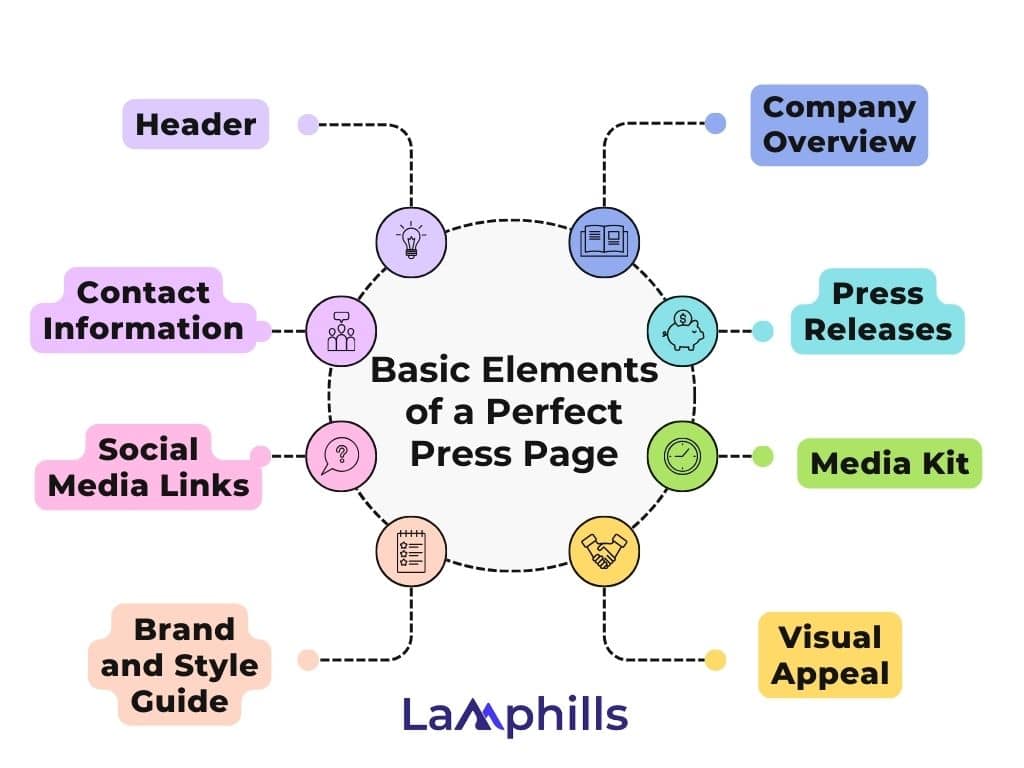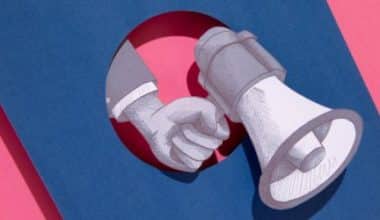Creating and maintaining Press Pages on your website can boost your brand’s visibility and credibility. I found this out when I started my blog and struggled to get noticed until I improved my press page.
The truth is that your marketing team won’t always get advance notification to provide quotes and recommendations for press articles. And even if they do get a heads-up, the time to respond might be very short.
A press page can help journalists find the information they need without contacting your team. If they do need to speak to someone, they can reach out directly without dealing with multiple layers of approval. But what makes a great press page, and how do you create one that works?
Let’s explore what press pages are, why they work, and how you can create an outstanding one, with some examples and templates.
Key Points
- A press page is a section on your website where journalists, bloggers, and other media professionals can quickly find information about your brand. It usually includes your company’s background, key facts, high-resolution images, press releases, and contact details.
- A well-designed, easy-to-find press page saves time for both you and your audience. It’s key to building good relationships with the media. With a good press page, you get more coverage without having to chase down journalists. This is called ‘Inbound PR.’
- Having a press page on your company’s website can significantly boost your SEO. When media outlets link to your press page, it creates valuable backlinks, which improve your site’s authority in search engines.
- By including the right elements, you can provide a professional and comprehensive resource that showcases your brand in the best light. These elements include; The Header, the Company Overview, Contact Information, Press Releases, Social Media Links, the Media Kit, Brand and Style Guide, Visual Appeal, and so on.
What Are Press Pages?
A press page, also called a media kit or press kit, is a section on your website where journalists, bloggers, and other media professionals can quickly find information about your brand. It usually includes your company’s background, key facts, high-resolution images, press releases, and contact details. Think of it as a one-stop shop for anyone looking to write about your brand.
A press page on your website is dedicated to your organization’s branding and press contacts. It often includes a company overview, mission statement, core values, and a list of executive leaders.
The purpose of a press page is to give journalists the information they need to write about your organization accurately and on-brand. When creating a press page, the goal is to provide everything the media might need to talk about your brand effectively.
Read Also: The 9+ Step Process for Clipping Press Coverage Effectively
Why Do You Need Press Pages?
For instance, a journalist wants to write a story about your product. They need information fast, without long email exchanges or endless Google searches. They go to your press page. The page is easy to find and use, and the information is clear. They get everything they need quickly.
The journalist feels great. You’ve made their job easier. Your site looks professional, they understand your brand better, and they can return to their work. This makes a big difference.
The benefit of having a press page is that general information about your company is publicly available. This means your marketing or PR team won’t have to answer calls and provide this information repeatedly.
Here are some other reasons why you should consider creating a press page on your company’s website:
#1. Inbound PR
An inbound PR is a public relations strategy that focuses on attracting media attention and building relationships by creating valuable content and engaging with the audience online. Instead of reaching out directly to journalists and media outlets, companies use blogs, social media, and other digital channels to share news, stories, and information that draw interest and coverage naturally.
It’s about being helpful, informative, and present where your audience already spends their time, making it easier for them to find and talk about your brand.
A well-designed, easy-to-find press page saves time for both you and your audience. It’s key to building good relationships with the media. With a good press page, you get more coverage without having to chase down journalists. This is called ‘Inbound PR.’
#2. Outbound PR
An outbound PR is a public relations strategy where a company actively reaches out to media, journalists, and influencers to promote its news, products, or services. This approach involves sending press releases, pitching stories, and building relationships to get coverage and publicity. It’s about pushing the company’s message out to the public through various media channels.
‘Outbound PR’ is when you pitch your news to the media. A great press page is crucial for this too. The links in your pitch should lead to your well-organized press page. Like a treasure trove, it should have everything the media needs, neatly arranged.
#3. Builds Brand Credibility with Journalists
A press page helps to build brand credibility with journalists. This means that when journalists visit the press page, they find trustworthy and useful information about the company. This makes it easier for them to write accurate and positive stories, which in turn makes the company look more reliable and professional to the public.
By improving your press page, you show that you value journalists’ time. They are busy and prefer finding information quickly and easily.
#4. Shapes Your Company’s Story
Online media can spread information in many ways. With a good press page, you control how your story is told by giving journalists and the public easy access to important information about the company.
This page can include press releases, news articles, company background, key facts, and contact details. By having a dedicated press page, the company can ensure that its story is told accurately and consistently, highlighting what makes the company unique and important. This helps build a positive image and trust with the audience.
#5. Increases Trust with Customers and Clients
A press page on a company’s website helps increase trust with customers and clients because it shows that the company is transparent and reputable. When customers see news articles, press releases, and media mentions on the press page, they feel more confident that the company is reliable and recognized by others. It makes the company look professional and trustworthy.
Potential customers and clients often explore a company’s website before making a purchase. A well-organized press page can build trust and help them feel confident in their decision.
#6. Boosts Your SEO
Having a press page on your company’s website can significantly boost your SEO. When media outlets link to your press page, it creates valuable backlinks, which improve your site’s authority in search engines. This increased authority helps your website rank higher in search results, making it easier for potential customers to find you.
Additionally, a press page often contains fresh, relevant content, which search engines love. This regular content update keeps your site active and interesting to search engines. Moreover, having a press page helps you control the narrative and ensure accurate information about your company is available. Overall, a press page enhances your online presence and drives more organic traffic to your site.
#7. Keeps Everything Organized
A company needs a press page to keep everything organized. This means having one place where all important information, news, and updates about the company are easily accessible. A press page helps journalists, customers, and anyone interested quickly find press releases, contact details, media kits, and recent news. It makes it simple for everyone to get the information they need without searching all over the website.
A tidy press page with all the necessary elements like a press kit, images, and logos makes it easier for journalists to find what they need. This shows you appreciate their work and can improve your online marketing efforts.
Overall, a press page gives anyone who wants to write about your business access to accurate information.
Creating a press page that stands out is crucial for any company. A well-designed press page helps journalists find everything they need quickly and easily, making it more likely that they will write about your company. This brings us to the key elements of a press page.
Basic Elements of a Perfect Press Page

By including the right elements, you can provide a professional and comprehensive resource that showcases your brand in the best light. Here are the key elements that make up a perfect press page:
#1. Header
The header is the top part of your press page. It should clearly say “Press” or “Media” so people know they are on the right page. Think of it like a big sign at the entrance of a store that tells you what the store sells.
#2. Company Overview
This section gives a brief description of your company. It should explain what your company does, its mission (what you aim to achieve), and its vision (what you see for the future). This helps visitors quickly understand what your company is all about.
The goal is to make sure visitors understand what the company does quickly and without any confusion. Here are some key points to include:
- When the company started and who started it (founders, investors, etc.)
- What the company does
- Where the office(s) are located
- The size of the company
- Important growth statistics
#3. Contact Information
Journalists need to contact you easily. At the very least, you should provide the phone number or email address of the person who handles media requests for the company. Depending on the company’s size and industry, you may also want to include the name(s) of the contact person, a mailing address, and details about other office locations.
#4. Press Releases
These are official announcements from your company about important news. They should be listed with the newest ones at the top. Think of them as news articles that tell everyone what’s happening with your company.
Take for instance Facebook, which creates its press releases to be both informative and easy to read. Visitors can quickly scroll through the page, seeing headlines with images and short explanations of the news.
#5. Social Media Links
Provide links to your social media profiles. This allows journalists to follow you, see your latest updates, and tag your company in their posts.
Has your client been mentioned in an article? Are there any awards the company won or has been nominated for? Has a product or service been highlighted in a well-known publication?
All of these should be linked on the press page because showing media coverage makes the company look trustworthy and important.
#6. Media Kit
A media kit is a downloadable package that contains useful materials for journalists. This includes your logo, photos, brand guidelines, and any other files they might need to write about your company. It’s like giving them a toolbox to use when they write their stories.
When a media source wants to write about a company, they need important materials like images, bios, and social media links. To avoid constant back-and-forth requests, your client’s press page should have:
- Logos: Include different versions of the company’s logo, like a dark version and a light version, so they work well on any background.
- Screenshots: If your client has an app or software, include clear and current screenshots. More views are better.
- Headshots and Bios: Provide high-quality headshots and up-to-date bios of the company’s CEO, founders, or executives. Include links to their social media accounts.
- Office Photos: These are less important but useful for articles that feature the company.
#7. Brand and Style Guide
Your press page should also have a brand and style guide. This helps the press know how to talk about your brand.
A brand and style guide includes:
- Brand Colors, Typefaces, and Logo Usage: Guidelines on how to use these elements.
- Tone and Voice Recommendations: Tips on how to communicate in line with the brand’s voice.
- Videography and Photography Guidelines: Rules for using video and photos.
For example Canva’s press page. It has four tabs at the top for easy access to news releases, visual media, brand guidelines, and official contacts.
#8. Visual Appeal
Images are very important. Including high-resolution logos, product photos, and team pictures can make your brand more attractive. Again, I remember getting featured in a major online publication, and they specifically mentioned how the quality of my images made their job easier.
Your press page should look clean and professional. Use simple, easy-to-read fonts, high-quality images, and good use of white space (areas without text or images). This makes the page inviting and easy to navigate.
Other Elements Includes:
#9. Testimonials and Quotes: These are positive statements from customers, partners, or influencers about your company. They add credibility because they show that other people think highly of your company.
#10. In the News: This section highlights articles and features about your company from well-known publications. Include the logos of these publications and links to the articles. It’s like showing off your report cards to prove you’re doing a good job.
#11. Company Timeline: A timeline shows the important events and milestones in your company’s history. This helps journalists see how your company has grown and achieved success over time.
#12. FAQs: Frequently Asked Questions (FAQs) are common questions that people often ask about your company. This section provides quick answers, saving time for both the journalists and your team.
#13. Search Bar: A search bar helps visitors quickly find specific information on your press page. It’s like a map that guides them to what they’re looking for without having to read everything.
Points to Note:
- Easy Navigation: Your press page should be easy to navigate. Journalists are often on tight deadlines, and a complicated layout can be a problem. Grouping information logically and using clear headings can make a big difference.
- Regular Updates: An outdated press page can hurt your credibility. I update my press page every few months, adding new press releases, recent achievements, and fresh images. This habit has kept my media coverage consistent over the years.
These elements combined make your press page a valuable resource for journalists, providing them with everything they need to write about your company efficiently and effectively.
Examples of Companies with Effective Press Pages
Having an effective press page is crucial for companies to provide journalists with the information they need quickly and easily. Here are examples of companies with outstanding press pages:
Apple
Apple’s press page is very organized and easy to navigate. It has sections for the latest news, press releases, product images, and videos. Everything is high quality and up-to-date. The clear sections, high-quality visuals, and regular updates make it very effective.
Canva
Canva’s press page features tabs at the top for news releases, visual media, brand guidelines, and contacts. This layout allows journalists to find what they need quickly. Easy navigation, comprehensive brand guidelines, and clear contact information are the key strengths of Canva’s press page.
Tesla
Tesla’s press page includes news releases, product photos, and videos. It also provides detailed information about their products and technology, which is helpful for journalists writing in-depth articles. Detailed product info, high-quality images and videos, and a comprehensive news section make Tesla’s press page stand out.
Airbnb
Airbnb’s press page has a clean layout with sections for company news, media resources, and brand assets. It also includes stories and case studies that show the impact of Airbnb. The clean layout, engaging stories, and a variety of media resources make Airbnb’s press page very effective.
Microsoft
Microsoft’s press page is very user-friendly. It offers the latest news, press releases, and a large library of images and videos. Additionally, it includes detailed information about their executives. The user-friendly design, extensive media library, and detailed executive bios contribute to the effectiveness of Microsoft’s press page.
How to Create Your Press Pages (Plus Templates)
Creating a press page is important for making it easy for journalists to find and use information about your company. Follow these simple steps to build an effective press page:
Step 1: Gather Your Content
Start by collecting all necessary information and materials. This includes your company history, mission statement, key personnel bios, high-resolution images, recent press releases, and any relevant awards or recognitions.
Step 2: Design and Layout
Choose a clean, professional layout. Use a content management system (CMS) that allows for easy updates. WordPress, for example, offers several press page templates that are both functional and good-looking.
Step 3: Write Clear Copy
Your press page should be concise but informative. Write clear, engaging copy that tells your brand’s story and value. Include quotes from key people and any significant milestones.
Step 4: Add High-Quality Visuals
Include high-quality images of your logo, products, office, team members, and, if possible, videos. These visuals help journalists add context to their stories. Make sure these visuals are easy to download and organized logically.
Step 5: Write Bios and Headshots
Write short biographies and gather professional headshots of your key team members, like the CEO and founders. Include links to their social media profiles.
Step 6: Include Press Releases
Add your latest press releases to the page. This keeps journalists updated on your company’s recent news and achievements.
Step 7: Implement Easy Navigation
Make sure your press page is easy to navigate. Use headings and subheadings to organize information, and consider adding a search function if you have a lot of content.
Step 8: Include Contact Information
Provide direct contact details for your media representative. If possible, include a contact form to make inquiries easier.
Step 9: Create a Brand and Style Guide
Develop a guide that includes your brand’s colors, fonts, logo usage, and tone of voice. This helps journalists represent your brand correctly.
Step 10: Add Downloadable Resources
Provide downloadable files of your logos, product images, and other important visuals. This saves journalists time and ensures they use the right materials.
Step 11: Regular Updates
Schedule regular updates to your press page. This could be every few months or twice a year, depending on how active your brand is.
Step 12: Test Your Page
Before launching, test your press page to make sure everything is working properly and that it’s easy to use.
By following these steps, you can create a press page that provides all the information journalists need to write about your company effectively.
Templates
Here’s a Template for an Effective Press Page
This template ensures that all necessary information is easily accessible for journalists, making it simple for them to find and use the resources they need to cover your company effectively.
Wrap Up
In conclusion, creating a good press page requires detailed information, high-quality visuals, and an easy-to-use design. By putting in the effort to develop and maintain your press page, you can greatly improve your brand’s visibility and credibility. I’ve seen the impact, and it’s worth the effort.
Frequently Asked Questions
What are press pages?
Your press page is the public face of your brand. Unlike other news stories, you control what is said here. It is the well-curated core of your company. This is where journalists, customers, and others come for the latest information about you.
How to Make a Press Page for Your Small Business Website
Here are seven tips to help you create a press page:
1. Give Complete Information: Include all important details about your business.
2. Share Contact Details: Provide contact information for a press contact person.
3. Show Press Mentions: Add any articles, editorials, and interviews about your business.
4. Include Press Releases: Add any official news or announcements from your business.
5. Provide Downloadable Images: Offer high-quality images that the press can use.
6. Think About Press Kits: Consider offering a collection of resources for the press.
How do you write a press example?
How to Write a Press Release
1. Write an Attention-Grabbing Headline
– Make it short and interesting to catch people’s attention.
2. Add a Subheadline for More Details
– Give a little more information under the headline.
3. Explain Why the News is Important
– Tell why this news matters and why people should care.
4. Include a Memorable Quote
– Add a quote from someone involved to make it more interesting.
5. Give Background Information
– Provide some context and details about the topic.
6. Summarize the Main Points
– Briefly explain who is involved and what is happening.
7. Add Contact Information
– Include the name, email, and phone number of someone who can answer questions.
8. Proofread Before Publishing
– Check for mistakes and make sure everything is clear and correct.
How to start a press statement?
Begin the first paragraph with the location of the event and a brief introduction of what the press release is about. Media outlets want a newsworthy announcement, so include three of the five Ws—when, where, and why.
Related Articles
Media Pitch vs. Press Release: How I Differentiate Them.
The 9+ Step Process for Clipping Press Coverage Effectively
How to Send a Press Release to Local Media (+ Expert Tips)






